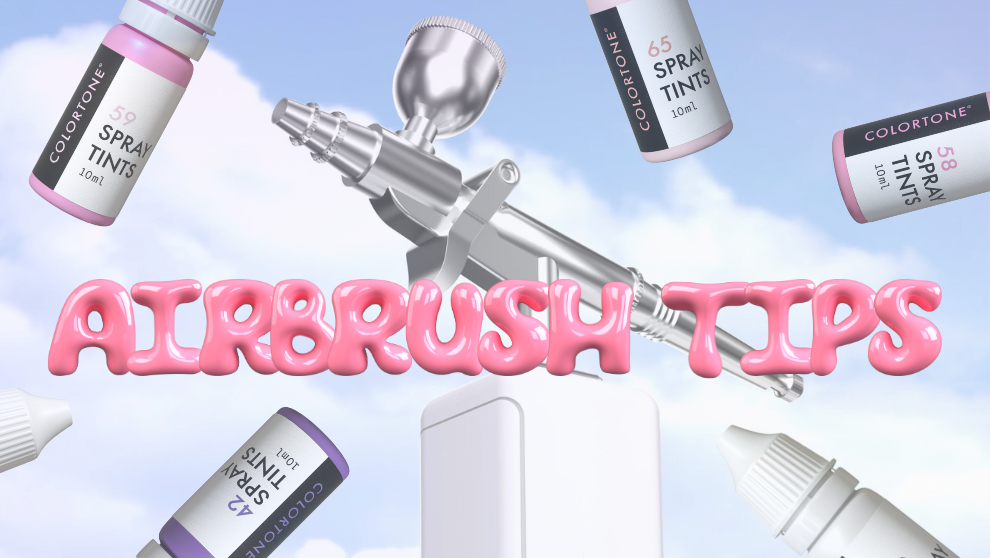
Tips for working safely with an airbrush.
|
|
Time to read 4 min
|
|
Time to read 4 min
Are you going to work with an airbrush for the first time, or do you just want to know more about working with an airbrush as safely as possible? We have listed some tips and facts for you!
You've probably heard of the fascinating world of airbrush technology, or maybe you're already an airbrush pro yourself. It is without a doubt one of the most fun and easy ways to create cool nail art. IF you have the technology under control to be honest... otherwise you would rather throw everything away! I have actually worn out a number of them. But with an airbrush in hand, you can effortlessly create a perfect baby tree, create a beautiful ombre, and even apply stunning stenciled prints - the sky's the limit!
When it comes to airbrushing, safety is an absolute priority. After all, you don't want to take any risks when it comes to your own health and that of your customers. In our latest blog post, we share essential tips and guidelines to ensure you can shine with the airbrush technique without worrying about potential health issues.
A nail salon is all about creating beautiful technical sets, nail art designs and offering relaxation to customers. But in addition to creativity and professionalism, there is another aspect that should not be overlooked: ventilation. It may not be the most glamorous topic, but it is crucial to the health and well-being of nail technicians and clients alike.
Airbrush designs sometimes use chemical products such as gel polish in combination with acetone. These products can release harmful fumes and chemicals. Prolonged exposure to these fumes can lead to breathing problems, headaches, skin irritation and other health problems. A well-ventilated area ensures that these fumes are removed effectively, reducing exposure to toxic substances.
The airbrush trend has taken the nail industry by storm, and it's no wonder why. However, amid all the benefits lies a potential danger that is often overlooked: contact allergy.
The ingredients in gel polish, such as acrylics, can cause contact allergies in some people. This means that even if you haven't had any problems with gel polish in the past, you may at some point become allergic to the ingredients.
You can recognize contact allergy by skin irritation around the nails and fingers. Symptoms may include:
Redness and swelling around the nails.
Loosening of the nail plate.
Blisters or rash.
A burning sensation.
Dry and flaky skin.
It's important to take these symptoms seriously because untreated allergies can lead to long-term skin problems.
We strongly recommend choosing water-based airbrush paint that is non-toxic. This minimizes the risks associated with using chemical products on the skin and ensures that the skin is treated kindly.
The benefits of the Spray tints, for example, are numerous. Not only is it safer for health, but it also provides excellent coverage. Plus, it's much easier to remove from the skin!
If your gel is not completely hardened and still spreadable after airbrushing, it may be that too much moisture is used. This could be because there is still too much water in your airbrush after cleaning, or if you are working with acetone, your mix ratio may not be optimal. This ensures that the gel does not harden properly.
When you use a water-based spray paint, it must dry thoroughly. Otherwise the quality of the spray paint cannot be good.
Try to 'play' with your ratio of gel polish and acetone to get the right consistency. Or of course opt for a ready-made spray paint for optimal quality. For example, the Spray Tints from Colortone!
You don't necessarily need training if you work safely, especially if you are a beginner. But if you plan to work with gel polish and acetone, we recommend that you take a course to prevent the development of allergies or other problems. In this case, prevention is always better than cure!
If you have little to no experience, using the Spray Tints mentioned above is the most beginner-friendly . You don't have to mix these shades. They also air dry and do not need to be cured in a UV/LED lamp.
That completely depends on how you go about it! In the beginning you will certainly make more 'mess' than if you have worked with an airbrush many times before. To prepare you well for your set and creating a design, we will take you through our must-haves for working (neatly) with an airbrush.
Paper towels are your BFF when using the airbrush. For example, if you want to change color, empty your airbrush onto a piece of paper towel and wipe away any residue from your surfaces. Make it fun by purchasing paper towels with a nice print, such as this one from Albert Heijn .
A pipette is your magic trick to work quickly. You use this to put water in your cup, so that you can rinse the color in your airbrush or to completely clean your airbrush at the end of your treatment.
